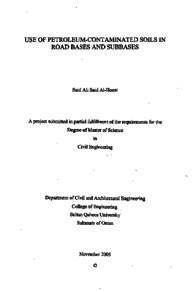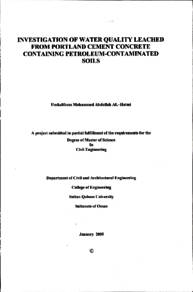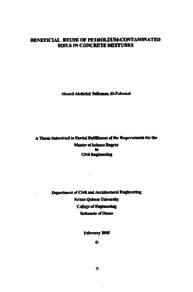Document
Use of petroleum-contaminated soils in road bases and subbases
Publisher
Sultan Qaboos University
Gregorian
2005
Language
English
English abstract
Petroleum-contaminated soils (PCS) result from leaking underground storage tanks, oil spills on clean soils, or soils surrounding petroleum refineries and crude oil wells. Contaminated soils typically consist of sand, silt and may have clay soil with the petroleum product.
PCS disposal techniques include: landfilling; bioremediation; low temperature desorption; and possible use as construction materials. Landfill disposal is not considered a real disposal option as the process continues to carry a liability of a contaminated soil generator. The thermal process is suspected to cause air pollution. The use of PCS in construction applications appears to be the most efficient technique. Still engineering and environmental aspects need to be investigated.
In Oman Petroleum Development of Oman (PDO) generates approximately 53,000 tons/year of untreated petroleum-contaminated soils. PDO faces a real challenge to dispose of huge amounts of PCS.
This research investigated the potential use of PCS in road bases and subbases. Raw materials used in the research study include: untreated PCS; treated PCS; virgin subbase aggregates and virgin base aggregates. Research tasks included: (1) literature review; (2) materials characterization; (3) mechanical-based testing of optimum blends of PCS and virgin aggregates; and (4) leachate-based testing of selected mixtures using the Toxicity Characteristic Leaching Procedure.
Results indicated that: (1) both treated and untreated PCS don't meet gradation requirements for road bases and subbases set forth in Oman's specifications; (2) optimum blends of PCS with virgin subbase aggregates include: (a) 25% treated PCS with 75% virgin aggregates; (b) 25% untreated PCS with 75% virgin aggregates; and (c) 5% treated PCS + 20% untreated PCS + 75% virgin aggregates; (3) optimum blends of PCS with virgin base aggregates include: (a) 15% treated PCS with 85% virgin aggregates; (b) 20% treated PCS with 80% virgin aggregates; (c) 15% untreated PCS with 85% virgin aggregates, and (d) 5% treated PCS + 15% untreated PCS + 80% virgin aggregates; (4) raw untreated or treated PCS would meet Oman's specifications of a California Bearing Ratio (CBR) requirement of 30% for road subbases; (5) all mixtures of virgin subbase or base aggregates with PCS would meet Oman's specifications for a Class B road subbase CBR requirement of 30%; (6) however, only one blend of 15% untreated PCS with 85% virgin base aggregates would meet Oman's specifications for a Class B road base CBR requirement of 100%; (7) because of the high CBR requirement (100%) for road base, it is not recommended to use PCS in the base layer; (8) however, it would be feasible to use combinations of treated and untreated PCS (up to 25%) with virgin subbase aggregates in the road subbase structure and (9) the toxicity characteristic leaching procedure (TCLP) test results indicate that the concentrations of heavy metals and toxic organics in treated PCS; untreated PCS; and mixtures of untreated or treated PCS with virgin base aggregates and virgin subbase aggregates are well below the United States Environmental Protection Agency (USEPA) leachate standards.
Recommendations for further work include the construction and evaluation field test sections incorporating mixtures of untreated and treated PCS in the road subbase structure. This evaluation should include both mechanical and environmental assessment of the field test sections.
Member of
Resource URL
Arabic abstract
التربة الملوثة بالنفط تنتج من تسريب خزانات النفط تحت الأرض أو بقع النفط على التربة النظيفة، أو التربة التي تحيط بآبار النفط الخام ومصافي النفط. وهي تتكون في الغالب من الرمل و الطمي او الطين بالاضافه الى النفط تقنيات التخلص من التربة الملوثة بالنفط تتضمن bioremediation: : landfilling ؛ درجة الحرارة المنخفضة desorption ؛ وإستعمالها كمواد بناء. كما أن دفن النفايات لا يعتبر خيار رمي حقيقي. إن العملية الحرارية تتوقع لتسبب تلوث الهواء. ان إستعمال التربة الملوثة بالنفط في تطبيقات البناء يبدو التقنية الأكثر كفاءة الا انه يتوجب دراسة المواصفات و الخصائص الهندسية والتأثيرات البيئية في عمان، شركة تنمية نفط عمان تولد تقريبا 53, 000 طن / سنة من التربة الملوثة بالنفط شركة تنمية نفط عمان تواجه تحدي حقيقي في كيفية التخلص من الكميات الضخمة من التربة الملوثة بالنفط تحري هذا البحث الإستعمال المحتمل للتربة الملوثة بالنفط في قواعز الطريق الأساسية (Base) والثانويه (Subbase). المواد الأولية المستخدمه في دراسة البحث تتضمن: التربة الملوثة بالنفط الغير معالجة؛ التربة الملوثة بالنفط المعالجة؛ التربه المستخدمه في الطبقه الثانويه للطريق (Subbase) و التربة المستخدمه في الطبقة الأساسية للطريق (Base). أغراض البحث تضمنت: (1) مراجعه للبحوث والدراسات السابقة؛ (2) تمثيل مواد؛ (3) اجراء الإختبار الميكانيكي على خلطات التربة الملوثة بالنفط و التربة المستخدمة في الطبقه الثانويه للطريق (Subbase) و التربة المستخدمه في الطبقه الأساسية للطريق (Base)؛ و(4) اجراء إختبار (TCLP) للخلطات المختارة لغرض دراسة التأثيرات المحتمله على البيئة المحيطة اشارت النتائج إلى: (1) كل من التربة الملوثة بالنفط المعالجة والغير معالجة لا ئلبي متطلبات التدريج القواعد الطريق طبقا للمواصفات العمانية؛ (2) خلطات التربة الملوثة بالنفط مع التربة المستخدمه في الطبقه الثانويه الطريق (Subbase) تتضمن :(أ) % 25تربة ملوثة بالنفط معالجه مع 75 % مع تريه الطبقه الثانويه للطريق (Subbase)؛ (ب) % 25 تربة الملوثة بالنفط غير معالجة مع 75 % تربه الطبقه الثانويه للطريق (Subbase)؛ و(ج) %5 تربة ملوثة بالنفط معالجه + 20% التربة الملوثة بالنفط غير معالجة + 75% تربه الطبقه الثانويه للطريق (Subbase)؛ (3) خلطات التربة الملوثة بالنفط مع التربة المستخدمة في الطبقة الأساسية للطريق (Base) تتضمن :(1) % 15 تربة الملوثة بالنفط معالجه مع 85 % تربه الطبقة الاساسية للطريق (Base)؛ (ب) % 20 تربة الملوثة بالنفط معالجه مع 80 % تربه الطبقه الاساسية للطريق (Base)؛ (ج) % 15 تربة الملوثة بالنفط غير معالجة مع 85 % تربه الطبقه الاساسيه للطريق (Base)؛ و(د) % كتربة الملوثة بالنفط معالجه + % 15 تربة ملوثة بالنفط غير معالجة + 80% تربه الطبقه الاساسيه للطريق (Base)؛ (4) التربة الملوثة بالنفط غير المعالجة أو المعالجة تلبي المواصفات العمانيه لمتطلب (CBR) وهو30% بالنسبه الطبقه الثانويه للطريق ؛ (5) كل خلطات تربه الطبقه الثانويه للطريق أو الأساسية مع التربة الملوثة بالنفط تلبي المواصفات العمانيه لمتطلب (CBR) وهو30% بالنسبه للطبقه الثانويه؛ (6) فقط مزيج واحد وهو 15 % التربة الملوثة بالنفط غير معالجة مع 85 % تربه الطبقه الاساسية للطريق (Base) يلبي المواصفات العمانيه لمتطلب (CBR) بالنسبه للطبقه الاساسيه (Base) وهو 100 %4 (7) بسبب متطلب (CBR العالي (100 %) لقاعدة الطريق (Base)، لذلك لإيوصى باستعمال التربة الملوثة بالنفط في الطبقة الأساسية؛ (8) يمكن استعمال مجموعات التربة الملوثة بالنفط المعالجة والغير معالجة (حتى 25 %) مع التربة المستخدمه في الطبقه الثانويه للطريق (Subbase) (9) تشير نتایج إختبار (TCLP) على المعادن الثقيلة والمواد العضوية السامة في التربة الملوثة بالنفط المعالجة و الغير معالجة وخلطات التربة الملوثة بالنفط الغير معالجة أو المعالجة مع التربة المستخدمه في الطبقه الثانويه للطريق (Subhase) و التربة المستخدمه في الطبقة الأساسية للطريق (Base) إلى أن نسب هذه المواد اقل بكثير من معايير وكالة الحماية البيئية الأمريكية (USEPA). التوصيات للعمل المس ت قبلي تتضمن: عمل حقل إختبار لاستخدام التربة الملوثة بالنفط الغير معالجة والمعالجة في الطبقه الثانويه للطريق (Subbase) . هذا التقييم يجب أن يتضمن كلا من التقييم الميكانيكي والبيئي.
Category
Theses and Dissertations



